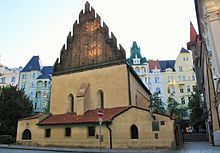Old New Synagogue
| Old New Synagogue | |
|---|---|

View from the west
|
|
| Basic information | |
| Location | Prague, Bohemia, Czech Republic |
| Affiliation | Orthodox Judaism |
| Ecclesiastical or organizational status | Active |
| Website | The Old-New Synagogue in Prague |
| Architectural description | |
| Architectural style | Gothic |
| Completed | 1270 |
The Old New Synagogue or Altneuschul (Czech: Staronová synagoga; German: Altneu-Synagoge) situated in Josefov, Prague, is Europe's oldest active synagogue. It is also the oldest surviving medieval synagogue of twin-nave design.
Completed in 1270 in gothic style, it was one of Prague's first gothic buildings. A still older Prague synagogue, known as the Old Synagogue, was demolished in 1867 and replaced by the Spanish Synagogue.
The synagogue was originally called the New or Great Synagogue and later, when newer synagogues were built in the 16th century, it became known as the Old-New Synagogue. Another explanation derives the name from the Hebrew עַל תְּנַאי (al tnay), which means "on condition" and sounds identical to the Yiddish "alt-nay," or old-new. According to legend angels have brought stones from the Temple in Jerusalem to build the Synagogue in Prague — "on condition" that they are to be returned, when the Messiah comes, i.e., when the Temple in Jerusalem is rebuilt and the stones are needed.
Nine steps lead from the street into a vestibule, from which a door opens into a double-nave with six vaulted bays. This double-nave system was most likely adapted from plans of monasteries and chapels by the synagogue's Christian architects. The molding on the tympanum of the synagogue’s entryway has a design that incorporates twelve vines and twelve bunches of grapes, said to represent twelve tribes of Israel. Two large pillars aligned east to west in the middle of the room each support the interior corner of four bays. The bays have two narrow Gothic windows on the sides, for a total of twelve, again representing the twelve tribes. The narrow windows are probably responsible for many older descriptions of the building as being dark; it is now brightly lit with several electric chandeliers.
...
Wikipedia
